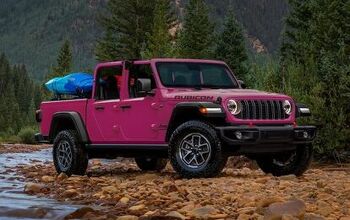Gas War: Appeals Court Upholds EPA Approval of California Emissions Rules

On Tuesday, a U.S. appeals court agreed to uphold the Environmental Protection Agency's decision to re-grant a waiver that allows California the ability to set its own tailpipe emissions limits and electric vehicle mandates.
For those that don’t recall this particular saga of the Great American Gas War, the EPA reinstated a waiver under the Clear Air Act that allowed California to establish vehicle emission rules that went beyond federal standards in 2022. Originally instituted by the Obama administration in 2013, the waiver was ended by the Trump administration in 2019 on the grounds that it effectively allowed California to move the nation toward more stringent fuel economy standards and mandatory electrification.
The stated concern was that the North American market would cater to California due to its relatively large economy, something Donald Trump alleged would result in a surplus of expensive EVs nobody wanted to buy and higher prices across the board. The matter quickly turned into a major legal battle between a coalition of blue states and the federal government. California and allied Democratic territories launched numerous lawsuits in a bid to avoid having its waiver revoked. It likewise demanded automakers make a formal agreement to adhere to its emissions standards (regardless of what the federal government said) if they wanted to continue selling products within its borders.
Joe Biden ultimately restored the waiver by executive order after taking office. Now under new leadership the EPA formally reinstated the waiver under the Clear Air Act to California in 2022. The federal regulators likewise did an about face regarding the Trump-era decision to prohibit other states from adopting the California tailpipe emission standards. That same year, the California Air Resources Board (CARB) finalized a plan to end the sale of gasoline vehicles sold within the state by 2035. The plan was likewise accompanied by rising requirements for zero-emission vehicle sales starting from 2026.
While the White House is technically supposed to be prohibited from deciding what Americans can and cannot purchase, the EPA recently updated tailpipe emission limits through 2032 that fall short of Californian standards. However, they’ll effectively require manufacturers to have a vehicle breakdown that’s at least half plug-in vehicles by 2030 to adhere to its goals.
All of the above has encouraged legal challenges from 17 Republican-led states that have alleged these decisions are effectively manipulating the automotive market and run the risk of crippling the oil industry. However, according to Reuters, the three-judge panel of the United States Court of Appeals for the District of Columbia has rejected the case.
From Reuters:
California Governor Gavin Newsom said the "court sided with common sense and public health against the fossil fuel industry and Republican-led states. This ruling reaffirms California’s longstanding right to address pollution from cars and trucks."
Republicans argued the rules gave California an unconstitutional regulatory power denied to other states.
The court rejected that argument and said reversing the EPA decision would address state claims if automakers responded by selling fewer EVs or by lowering prices of gas-powered models and said there was no evidence to support that conclusion.
While this isn’t the first time California has been granted a regulatory waiver by the EPA, it’s hard to argue that what the state is doing isn’t influencing the industry and shaping the American automotive landscape. Sadly, whether or not you think that’s a good thing probably has more to do with who you vote for than what you actually think. The issue has become almost a parody of partisan government.
As for the industry itself, despite many companies having agreed to follow California’s rules in the past, many are now questioning whether or not these goals are feasible. The Alliance for Automotive Innovation, an industry lobbying group representing just about every major manufacturer, has been so wishy-washy on the topic that it’s almost not worth listening to. But its current take is that the automotive sector might have trouble reaching the goals laid out by California and even the EPA. Meanwhile, automakers spent the last decade telling everyone that electric vehicles would reach parity with combustion-engine vehicles by 2025 and have relentlessly been messaging that they’re pivoting toward all-electric vehicles as quickly as possible.
[Image: Boeang Sadewa/Shutterstock.com]
Become a TTAC insider. Get the latest news, features, TTAC takes, and everything else that gets to the truth about cars first by subscribing to our newsletter.

A staunch consumer advocate tracking industry trends and regulation. Before joining TTAC, Matt spent a decade working for marketing and research firms based in NYC. Clients included several of the world’s largest automakers, global tire brands, and aftermarket part suppliers. Dissatisfied with the corporate world and resentful of having to wear suits everyday, he pivoted to writing about cars. Since then, that man has become an ardent supporter of the right-to-repair movement, been interviewed on the auto industry by national radio broadcasts, driven more rental cars than anyone ever should, participated in amateur rallying events, and received the requisite minimum training as sanctioned by the SCCA. Handy with a wrench, Matt grew up surrounded by Detroit auto workers and managed to get a pizza delivery job before he was legally eligible. He later found himself driving box trucks through Manhattan, guaranteeing future sympathy for actual truckers. He continues to conduct research pertaining to the automotive sector as an independent contractor and has since moved back to his native Michigan, closer to where the cars are born. A contrarian, Matt claims to prefer understeer — stating that front and all-wheel drive vehicles cater best to his driving style.
More by Matt Posky
Latest Car Reviews
Read moreLatest Product Reviews
Read moreRecent Comments
- 28-Cars-Later "elections"
- Tassos Good job, Senile, Corrupt Idiot-in-Chief.And when Inflation doubles again under your failed watch, LIE again that it was .. 9% when you took office, while THE REAL inflation then was less than 2%!Disgusting imbecile....
- Wjtinfwb Glad to see Toyota hanging in there with sedans. It's a bit clunky looking but no worse than a new BMW 7-series at 1/3 the price. More power would be nice but Toyota is married to the Hybrid/4-cylinder configuration. As this package gets refined I expect it will be come the norm.
- Wolfwagen The last couple of foreign vehicle manufacturers that tried breaking into the U.S. Mainstream Vehicle Market had a very hard time and 1. Couldn't get past the EPA regulation side (Mahindra) or 2. had a substandard product (Vinfast).
- Midori Mayari I live in a South American country where that is already the case; Chinese brands essentially own the EV market here, and other companies seem unable to crack it even when they offer deep enough discounts that their offerings become cheaper than the Chinese ones (as Renault found when it discounted its cheapest EV to be about 15% cheaper than the BYD Seagull/Dolphin Mini and it still sold almost nothing).What's more, the arrival of the Chinese EVs seem to have turbocharged the EV transition; we went from less than 1% monthly EV market share to about 5% in the span of a year, and it's still growing. And if — as predicted — Chinese EV makers lower their production costs to be lower than those of regular ICE cars in the next few years, they could undercut equivalent ICE car prices with EVs and take most of the car market by storm. After all, a pretty sizeable number of car owners here have a garage where they could charge, and with local fuel and electricity prices charging at home reduces fuel costs by over 80% compared with an ICE car.

































Comments
Join the conversation
I can predict what state auto groups WONT be building new dealerships in !
The future of America is Cal-if-or-nia!
-Vice President Kamala Devi Harris the Goddess of California